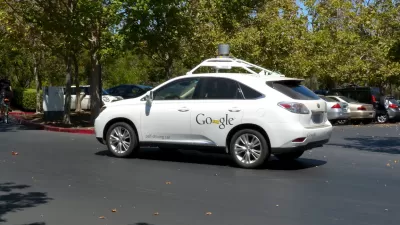As Nevada becomes the first state in the country to approve self-driving cars, Robert Bruegmann considers what changes to the built environment driverless cars could have.
The recently approved regulations allowing for the operation of self-driving vehicles on Nevada's roadways is a milestone in the rise of the driverless car, which are 'surely the future of automobiles," according to Department of Motor Vehicles director Bruce Breslow.
Drawing a connection between this revolution in personal transportation with other breakthroughs in transportation technology such as the railroad and the airplane, Bruegmann wonders if self-driving cars will lead to, "more dispersed, lower-density settlement patterns in almost every urban area in the world," as have prior innovations. While this outcome may seem likely, as congestion is reduced, it is by no means inevitable, claims Bruegmann.
"Given the large amount of space devoted to roads and parking in American cities, even minor increases in collective use of vehicles could lead to less need for new pavement and parking and to higher residential and commercial densities. This would reinforce a trend that is already visible, as new development at the far suburban edge of most urban regions is currently being created at higher densities than in the past and there is a great deal of infill in city centers and close-in suburbs."
The expected impact of the driverless car on the built environment is far from settled, but it is certain to erode the boundaries between public and private transportation.
FULL STORY: Driverless Car Could Defy the Rules of Sprawl: Robert Bruegmann

Alabama: Trump Terminates Settlements for Black Communities Harmed By Raw Sewage
Trump deemed the landmark civil rights agreement “illegal DEI and environmental justice policy.”

Planetizen Federal Action Tracker
A weekly monitor of how Trump’s orders and actions are impacting planners and planning in America.

The 120 Year Old Tiny Home Villages That Sheltered San Francisco’s Earthquake Refugees
More than a century ago, San Francisco mobilized to house thousands of residents displaced by the 1906 earthquake. Could their strategy offer a model for the present?

In Both Crashes and Crime, Public Transportation is Far Safer than Driving
Contrary to popular assumptions, public transportation has far lower crash and crime rates than automobile travel. For safer communities, improve and encourage transit travel.

Report: Zoning Reforms Should Complement Nashville’s Ambitious Transit Plan
Without reform, restrictive zoning codes will limit the impact of the city’s planned transit expansion and could exclude some of the residents who depend on transit the most.

Judge Orders Release of Frozen IRA, IIJA Funding
The decision is a victory for environmental groups who charged that freezing funds for critical infrastructure and disaster response programs caused “real and irreparable harm” to communities.
Urban Design for Planners 1: Software Tools
This six-course series explores essential urban design concepts using open source software and equips planners with the tools they need to participate fully in the urban design process.
Planning for Universal Design
Learn the tools for implementing Universal Design in planning regulations.
Clanton & Associates, Inc.
Jessamine County Fiscal Court
Institute for Housing and Urban Development Studies (IHS)
City of Grandview
Harvard GSD Executive Education
Toledo-Lucas County Plan Commissions
Salt Lake City
NYU Wagner Graduate School of Public Service





























